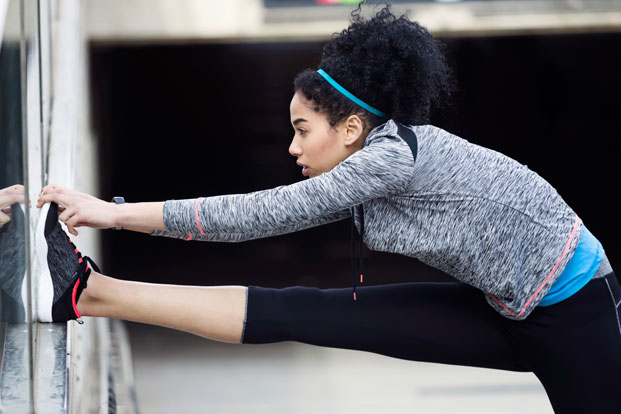Do your joints hurt?
Joint pain is a common condition. In fact, 30 percent of adults report pain, swelling or aching of the joints. This can make living an active life difficult.
That said, there are steps you can take to deal with joint pain. This begins with finding out exactly what’s causing the pain to confirm whether or not joint pain is the real issue.
“The average person may not be able tell if it’s the joint, a torn tendon or pain in the area of the joint,” Shannon Whetstone-Mescher, vice president of programs and services at the Arthritis Foundation, tells WebMD. “A physician needs to evaluate you to make sure you do in fact have joint pain and why.”
If joint pain is confirmed, you will want to follow your doctor’s advice regarding possible medications, supplements and physical therapy. And there are a number of stretches and exercises that can help to reduce pain in general.
Here are five options.
1. Wrist and Hand Stretches
Typing, holding a tennis racquet and other wrist-oriented activities can cause pain in the joints of the wrists and hands. Wrist and hand stretches may alleviate that pain.
According to Healthline, one activity that you can perform involves wrist circles. To perform this exercise, roll your hands around in circles. But be sure to do this slowly and in a gentle manner. This will stretch out the muscles of the wrists and hands.
You can even stretch your fingers with a simple exercise. First, make a fist. Hold it for about two seconds. Next, stretch your fingers far apart like you would if you were doing a handstand. Hold this for about four seconds.
For a tougher option, Healthline suggests a simple wall stretch. To perform this stretch, face a wall and turn arms so that palms face it. Next, press the palms into the wall. As you move your hands up higher, you’ll feel more of a stretch. Just don’t push yourself past your comfort level. Let your body guide you.
2. Stretch your feet.
Foot stretches are said to be particularly helpful in dealing with pain associated with psoriatic arthritis. This is a type of arthritis known to affect some people who have psoriasis.
Dr. M. Elaine Husani tells Everyday Health that increasing flexibility can help prevent injury in general. Husani says that one good exercise for the feet can be performed by placing feet flat on the ground and then pressing in a downward motion with your toes. Next, circle your ankles one at a time in both a right and left direction. Just make sure to stay balanced to prevent falls.
3. Stretch your calves.
According to Greatist, knee joints can be associated with many muscles — one of which involves the calves. “This means you want to think about stretching all the tissues around the knees,” Lauren Williams, a certified personal trainer and head coach at New York City’s athletic-based training studio Tone House, tells Greatist.
Greatist suggests a wall exercise that involves flexing the feet. To perform this exercise, face a wall and flex your toes upward while keeping your heels on the floor. Do this one foot at a time. Next, bend toward the leg to create a stretch. Remember that the straighter your leg is, the more of a stretch you will feel. When you feel the stretch, stop and hold it for five seconds. You can do this 10 to 15 times on each leg.
Another option is a common runner’s stretch. Lean in against a wall, facing the wall. Bring one leg toward the wall and place the other leg behind you with the feet a little less than hip-width apart. Bend the knee of the front leg so that it creates a calf stretch in the back leg. Then switch legs.
You can also perform leg stretches while lying down. The first way to do this is to use a yoga strap or a tie. Elevate one or both legs above your head, using the strap or tie for support. Pull your legs toward your head. You will feel a stretch in both your calves and hamstrings. Make sure to perform this exercise slowly and gently to avoid injury.
4. Engage in active stretching before you work out.
According to the Arthritis Foundation, you can use active stretching to warm up for a workout. These stretches mirror what you’d be doing in a sport or work out. This warms your body up by increasing both blood flow and muscle temperature.
To do this, choose activities that warm up the muscles you will use in the sport you plan to perform. For example, the Arthritis Foundation says that both side and front lunges would be an appropriate warmup for a tennis match. That’s because these are similar to the movements you will use in the game itself when you hit the ball. Just make sure to start off slowly. After all, this is a warmup.
5. Make low-impact exercise a part of your routine.
Another way to help the joints is to incorporate an exercise routine into your life. Whetstone-Mescher tells WebMD that a good way to do this is to work with a physical therapist.
“A physical therapist is key, especially if you don’t know where to start,” she notes. “They can tell you which exercises are best — usually those that improve strength, endurance, and range of motion — and recommend specific joint exercises designed specifically for pain relief.”
This is said to involve 40 minutes of exercise three to four times per week. One type of exercise often used is swimming. This is because swimming puts very little pressure on the joints. In addition, low-impact exercise is said to be an appropriate choice.
Whetstone-Mescher tells WebMD that jogging, for instance, may not be a good choice because of the pressure it puts on the joints. A better choice would be walking.

Leave a Reply